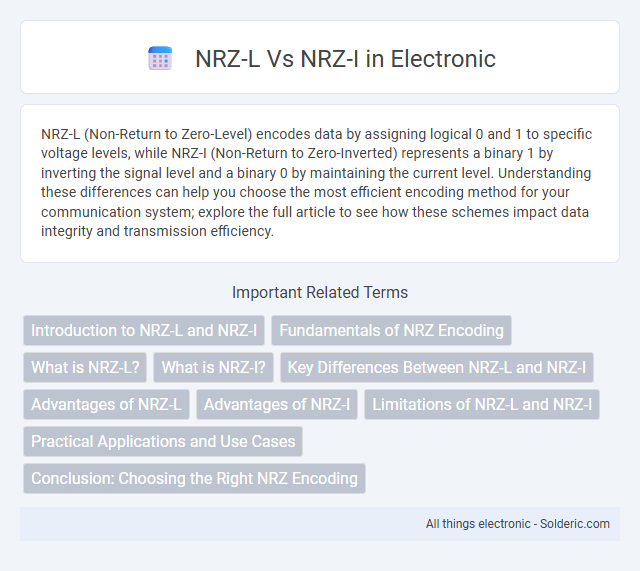NRZ-L (Non-Return to Zero-Level) encodes data by assigning logical 0 and 1 to specific voltage levels, while NRZ-I (Non-Return to Zero-Inverted) represents a binary 1 by inverting the signal level and a binary 0 by maintaining the current level. Understanding these differences can help you choose the most efficient encoding method for your communication system; explore the full article to see how these schemes impact data integrity and transmission efficiency.
Comparison Table
| Feature | NRZ-L (Non-Return to Zero-Level) | NRZ-I (Non-Return to Zero-Invert) |
|---|---|---|
| Definition | Signal level directly represents the bit value (high=0, low=1 or vice versa) | Signal changes level on a '1' bit; no change on '0' bit |
| Encoding Type | Level-based encoding | Transition-based encoding |
| Signal Transition | No transition for consecutive identical bits | Transition occurs at each '1' bit |
| Synchronization | Prone to synchronization issues with long runs of identical bits | Better synchronization due to guaranteed transitions on '1's |
| Complexity | Simple implementation | Moderate complexity due to transition detection |
| Applications | Basic digital communication systems | Used in protocols needing better synchronization, e.g., RS-232 |
| Advantages | Easy to implement; less hardware required | Improved clock recovery; reduced error rates on long bit sequences |
| Disadvantages | Poor clock recovery with long sequences of 0s or 1s | Complex decoding logic; transition ambiguity if error occurs |
Introduction to NRZ-L and NRZ-I
NRZ-L (Non-Return-to-Zero-Level) represents binary data by maintaining a constant voltage level throughout the bit interval, with one voltage level assigned to binary '1' and another to binary '0'. NRZ-I (Non-Return-to-Zero-Inverted) encodes binary data by inverting the voltage level only when a binary '1' is encountered, while a binary '0' keeps the voltage level unchanged. Both NRZ-L and NRZ-I are fundamental line coding schemes used in digital communication systems for efficient data transmission over physical media.
Fundamentals of NRZ Encoding
NRZ-L (Non-Return-to-Zero-Level) encoding represents binary data by assigning fixed voltage levels, where a high voltage typically corresponds to a binary '1' and a low voltage corresponds to a binary '0'. NRZ-I (Non-Return-to-Zero Inverted) encoding, on the other hand, encodes data by signal inversion; a binary '1' is indicated by a change in the voltage level from the previous bit, while a binary '0' maintains the same voltage level. Both NRZ-L and NRZ-I are fundamental line codes used in digital communication for efficient and simple data transmission without a return to zero voltage between bits.
What is NRZ-L?
NRZ-L (Non-Return to Zero-Level) is a binary signaling scheme where the signal level directly represents the data bit; a high voltage indicates a binary 0, and a low voltage indicates a binary 1. It differs from NRZ-I in that NRZ-I relies on transitions to indicate bits, while NRZ-L depends solely on signal levels. NRZ-L is commonly used in digital communication systems for its simplicity and ease of implementation.
What is NRZ-I?
NRZ-I (Non-Return-to-Zero Inverted) is a binary line coding technique where the signal changes its voltage level only when a binary "1" occurs, while a binary "0" causes no change. This inversion-based signaling makes NRZ-I more robust against synchronization errors compared to NRZ-L, which directly encodes the signal level for bits. Your communication system can benefit from NRZ-I by improving error detection and maintaining clock synchronization over longer distances.
Key Differences Between NRZ-L and NRZ-I
NRZ-L (Non-Return-to-Zero-Level) encodes data by representing binary values directly with voltage levels, where one level signifies a binary '1' and the other a '0'. In contrast, NRZ-I (Non-Return-to-Zero-Inverted) differentiates data based on voltage transitions, signaling a binary '1' with a change in voltage and a '0' with no change. Your choice between NRZ-L and NRZ-I depends on factors like error detection and synchronization needs, as NRZ-I generally offers better synchronization due to its transition-based encoding.
Advantages of NRZ-L
NRZ-L encoding offers the advantage of simplicity in implementation by representing binary data with fixed voltage levels, making it easier for hardware to decode signals without complex transitions. This consistent voltage level reduces the likelihood of signal distortion and noise, enhancing transmission reliability over longer distances. Your communication system benefits from lower power consumption and straightforward signal processing compared to NRZ-I, which relies on transitions to represent data.
Advantages of NRZ-I
NRZ-I (Non-Return-to-Zero Inverted) offers improved synchronization by encoding data transitions rather than levels, reducing the chance of long runs of zeros or ones common in NRZ-L (Non-Return-to-Zero Level). This makes NRZ-I more resilient to baseline wander and easier for receivers to maintain clock recovery. Your communication system benefits from enhanced error detection and reliable data transmission when using NRZ-I compared to NRZ-L.
Limitations of NRZ-L and NRZ-I
NRZ-L encoding suffers from synchronization issues and baseline wander, making it difficult to distinguish long sequences of identical bits. NRZ-I improves synchronization by encoding data as transitions rather than levels but still struggles with long runs of zeros, leading to potential timing errors. Your communication system may require more complex encoding methods to overcome these inherent limitations and maintain signal integrity.
Practical Applications and Use Cases
NRZ-L (Non-Return-to-Zero-Level) is commonly used in simple digital communication systems where direct voltage levels represent binary data, making it ideal for wired LANs and low-speed serial links. NRZ-I (Non-Return-to-Zero Inverted) is preferred in magnetic storage and communication systems prone to synchronization issues, as its signal changes on bit transitions help maintain clock recovery. Understanding the differences in practical application can enhance your system design by selecting the most efficient encoding method for data integrity and transmission reliability.
Conclusion: Choosing the Right NRZ Encoding
NRZ-L and NRZ-I differ primarily in how they represent binary data: NRZ-L uses signal levels directly corresponding to bits, while NRZ-I relies on signal transitions for data encoding. Your choice depends on the specific application requirements, such as synchronization ease and error detection capabilities. NRZ-I is generally preferred for better synchronization in long data streams, whereas NRZ-L offers simplicity for straightforward, short-distance communication.
NRZ-L vs NRZ-I Infographic

 solderic.com
solderic.com